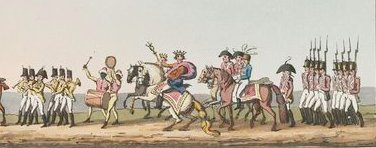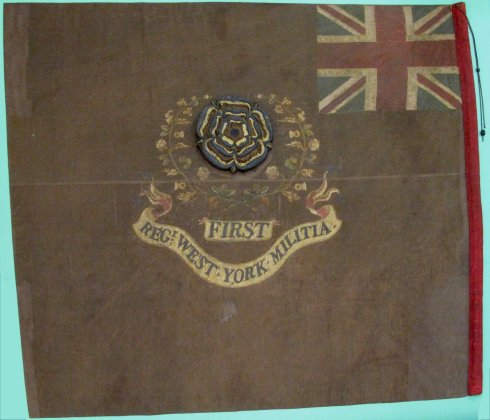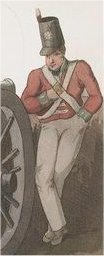A few posts on this site (here, here and here) have drawn upon a rich but sometimes enigmatic tailor’s note book in the Anne S K Brown Collection at Brown University, titled “Rigementals”[sic] and apparently the work of one William Stothard, circa 1813. (It has also informed many of my King’s German Legion pages.) Stothard’s background is not known, but he was certainly familiar with officers’ clothing produced by London tailors from 1811. A number of items in the book can be tied to entries in the ledger of Jonathan Meyer, and it’s possible that Stothard was at some point employed by Meyer, or perhaps apprenticed to him, or at least allowed to have a nose around and make copious “Memorandoms”.
Stothard’s drawings are crisp, detailed and accurate. His written notes are vernacular to a Dickensian level, and although you can almost hear his spoken voice behind the phonetics, it makes for some tricky reading at times. In addition to the seventy or so items of uniform recorded, many ornate and complex, Stothard includes a set of “Rules” for a military tailor, which makes interesting reading, even for those (like me) who can’t even thread a needle. Here’s the opening part, transcribed directly:
Tailours Rules for the Prince Reg.nt Regulation. 1813
Coates Jackets or Pantlones. A Coate being given in to be Baisted up should be marked properly if not otherways Ardered, do. for the Imbroidereys. The linings should be Baisted in Rongside oughtward for fear of Getting dirty; All Button stays should come from the Button to the front where hooks & eyes is wanted, & turn in the front, all hooks & eyes on Coates should be put on with A strip of Brown Holland other linen, abought three or four inches long, to ceepe them to their places. Thick things should be well stayed: thin things lightly stayed. All white things given in should be cept so White. Lace given in should be cept cleen. Figurin Braide should be passed up from the little finger to the thum, and the end braide inward should be used, the braide should lay cosey on the knee, Nighther two much ought nor two much in; All broade Lace should be Waxed Before it his Cut …
And so on. But here’s my attempt at a translation:
Coats, jackets or pantaloons. A coat being given in to be basted up should be marked properly if not otherwise ordered, ditto for the embroideries. The linings should be basted in wrong side outward for fear of getting dirty.
All button stays should come from the button to the front where hooks and eyes is wanted, and turn in the front. All hooks and eyes on coats should be put in with a strip of brown Holland or other linen, about three or four inches long, to keep them to their places. Thick things should be well stayed, thin things lightly stayed.
All white things given in should be kept so, white. Lace given in should be kept clean.
Figuring braid should be passed up from the little finger to the thumb, and the end braid inward should be used. The braid should lay cosy on the knee, neither too much out nor too much in. All broad lace should be waxed before it is cut. Cushions should be made on lace to turn downwards, all the points in. A First Guards dress flap should be cushions, though sometimes they are seamed, in the bottom point. Broad lace should never be seamed, only where there is one point such as the forearm of a dragoon’s lace cuff, or the frame of pantaloons of one inch or two inch laces.
To mark the figure for pantaloons [you] should find the nape of the knee, draw a line from the centre to the top. Ditto for sleeve.
All large figures should be marked with white ink and [the] pen should be good. Fancy patterns should be first drawn on paper then pricked with a pin. The pattern should be laid on where it is wanted and pinned on. The pipe clay should be finely scraped on then rubbed over with a brush. The pattern should be took off and the ink put on. That makes it plain to put on the braid. The pattern is best pricked with a pin. To make white ink dissolve one pennyworth of gum Arabic and one pennyworth of white lead. If too thick or too thin adulterate it accordingly. On stocking [it] is very bad to stick. On thin stocking it should be made [to] stick the best.
All plush linings to regimentals should run upwards and other linings downwards.
Mark 14 regular [i.e. buttons] for 10 by pairs. Mark 11 for 8 by pairs, 10 for 7.
Every tailor knows these things, etc. William Stothard.
Some of this may be of real interest to anyone involved in the re-creation of period uniform or costume. Next time you mark out an Austrian knot on your pantaloons you’ll know exactly how to set about it. I like the bit about spacing buttons in pairs; for eight, mark out eleven and miss out every third button. It works! As every tailor knows …
On a more familiar note, there are three more Militia pages now up and running here, for the First and Second West York from 1759 to 1816, and for the Third from 1797, plus two even shorter-lived “Supplementary” regiments. White roses in plenty.



















